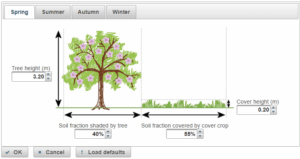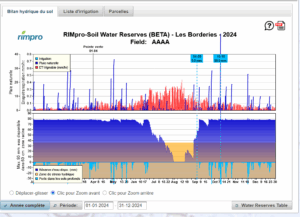Irrigation model
The irrigation model uses the dual crop coefficient approach to provide a robust and precise framework for managing water in vineyards and orchards, especially when inter-row cover crops are present. This method distinguishes between plant transpiration and soil evaporation, offering key advantages in perennial systems with mixed ground cover.
The Model
The RIMpro irrigation model is based on the” dual crop irrigation model”. It is a conceptual and simulation framework used to manage water more precisely in systems like orchards or vineyards, where there are two co-existing vegetation components:
- The main crop: Trees or vines – deep-rooted, permanent.
- The inter-row vegetation: Usually a cover crop, like grass, clover, or a managed native mix – shallow-rooted, seasonal or perennial.
The model typically separates evapotranspiration (ET) into 2 components:
ET = E+T
E: Evaporation from bare soil or cover crop
T: Transpiration from trees/vines and cover crops
The user defines a new field with :
- Crop (orchard/vineyard)
- Crop age
- Root zone depth
- Soil type
- Irrigation type (full field, microsprinkler, drip irrigation)
you can fin information about the different parameters of this table here
Based on these information, the model will load default values for the orchard or vineyard for the different periods of the year. The user can change the default values in his parameters to adapt it to his local situation. he can also add his irrigation schedule.

Based on these parameters the model will calculate the soil water balance based on
Where:
| ΔS | Change in soil water balance | (mm) |
| P | Precipitation (rainfall infiltration) | (mm) |
| I | Irrigation (net input) | (mm) |
| C | Capillary rise (from water table upward) | (mm) |
| ET | Evapotranspiration (crop + soil evaporation) | (mm) |
| D | Deep percolation (water draining below root zone) | (mm) |
When the available water drops below 40% (for vineyards) or 50% (for orchards) of the total available water, the model highlights an orange zone to indicate the onset of water stress.
